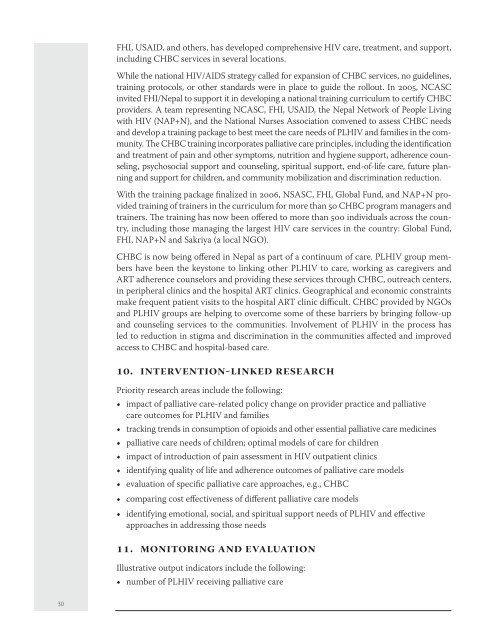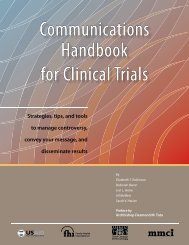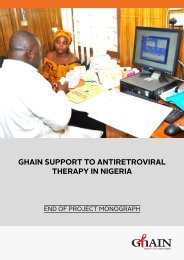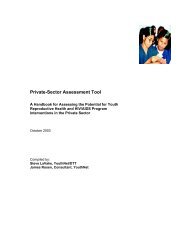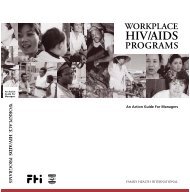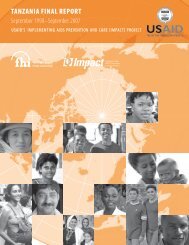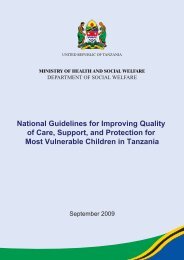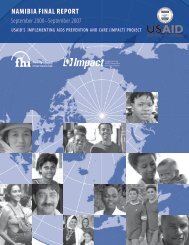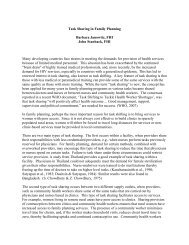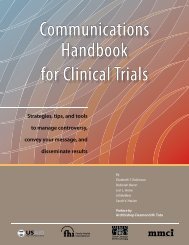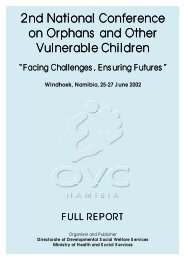Palliative Care Strategy for HIV and other diseases - FHI 360
Palliative Care Strategy for HIV and other diseases - FHI 360
Palliative Care Strategy for HIV and other diseases - FHI 360
Create successful ePaper yourself
Turn your PDF publications into a flip-book with our unique Google optimized e-Paper software.
30<br />
<strong>FHI</strong>, USAID, <strong>and</strong> <strong>other</strong>s, has developed comprehensive <strong>HIV</strong> care, treatment, <strong>and</strong> support,<br />
including CHBC services in several locations.<br />
While the national <strong>HIV</strong>/AIDS strategy called <strong>for</strong> expansion of CHBC services, no guidelines,<br />
training protocols, or <strong>other</strong> st<strong>and</strong>ards were in place to guide the rollout. In 2005, NCASC<br />
invited <strong>FHI</strong>/Nepal to support it in developing a national training curriculum to certify CHBC<br />
providers. A team representing NCASC, <strong>FHI</strong>, USAID, the Nepal Network of People Living<br />
with <strong>HIV</strong> (NAP+N), <strong>and</strong> the National Nurses Association convened to assess CHBC needs<br />
<strong>and</strong> develop a training package to best meet the care needs of PL<strong>HIV</strong> <strong>and</strong> families in the community.<br />
The CHBC training incorporates palliative care principles, including the identification<br />
<strong>and</strong> treatment of pain <strong>and</strong> <strong>other</strong> symptoms, nutrition <strong>and</strong> hygiene support, adherence counseling,<br />
psychosocial support <strong>and</strong> counseling, spiritual support, end-of-life care, future planning<br />
<strong>and</strong> support <strong>for</strong> children, <strong>and</strong> community mobilization <strong>and</strong> discrimination reduction.<br />
With the training package finalized in 2006, NSASC, <strong>FHI</strong>, Global Fund, <strong>and</strong> NAP+N provided<br />
training of trainers in the curriculum <strong>for</strong> more than 50 CHBC program managers <strong>and</strong><br />
trainers. The training has now been offered to more than 500 individuals across the country,<br />
including those managing the largest <strong>HIV</strong> care services in the country: Global Fund,<br />
<strong>FHI</strong>, NAP+N <strong>and</strong> Sakriya (a local NGO).<br />
CHBC is now being offered in Nepal as part of a continuum of care. PL<strong>HIV</strong> group members<br />
have been the keystone to linking <strong>other</strong> PL<strong>HIV</strong> to care, working as caregivers <strong>and</strong><br />
ART adherence counselors <strong>and</strong> providing these services through CHBC, outreach centers,<br />
in peripheral clinics <strong>and</strong> the hospital ART clinics. Geographical <strong>and</strong> economic constraints<br />
make frequent patient visits to the hospital ART clinic difficult. CHBC provided by NGOs<br />
<strong>and</strong> PL<strong>HIV</strong> groups are helping to overcome some of these barriers by bringing follow-up<br />
<strong>and</strong> counseling services to the communities. Involvement of PL<strong>HIV</strong> in the process has<br />
led to reduction in stigma <strong>and</strong> discrimination in the communities affected <strong>and</strong> improved<br />
access to CHBC <strong>and</strong> hospital-based care.<br />
10. intervention-linked research<br />
Priority research areas include the following:<br />
•<br />
•<br />
•<br />
•<br />
•<br />
•<br />
•<br />
•<br />
impact of palliative care-related policy change on provider practice <strong>and</strong> palliative<br />
care outcomes <strong>for</strong> PL<strong>HIV</strong> <strong>and</strong> families<br />
tracking trends in consumption of opioids <strong>and</strong> <strong>other</strong> essential palliative care medicines<br />
palliative care needs of children; optimal models of care <strong>for</strong> children<br />
impact of introduction of pain assessment in <strong>HIV</strong> outpatient clinics<br />
identifying quality of life <strong>and</strong> adherence outcomes of palliative care models<br />
evaluation of specific palliative care approaches, e.g., CHBC<br />
comparing cost effectiveness of different palliative care models<br />
identifying emotional, social, <strong>and</strong> spiritual support needs of PL<strong>HIV</strong> <strong>and</strong> effective<br />
approaches in addressing those needs<br />
11. monitoring <strong>and</strong> evaluation<br />
Illustrative output indicators include the following:<br />
•<br />
number of PL<strong>HIV</strong> receiving palliative care


